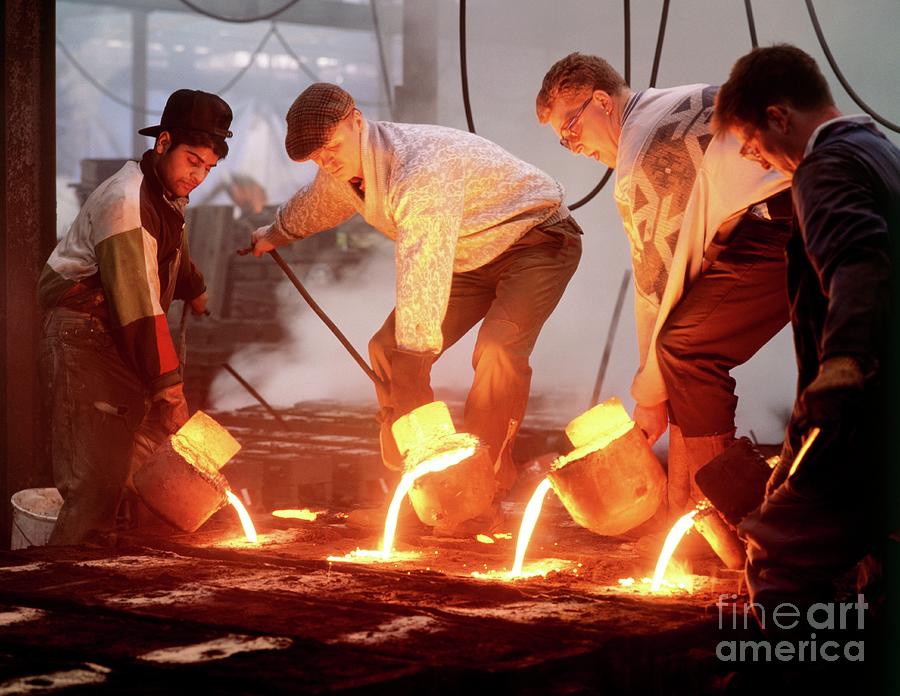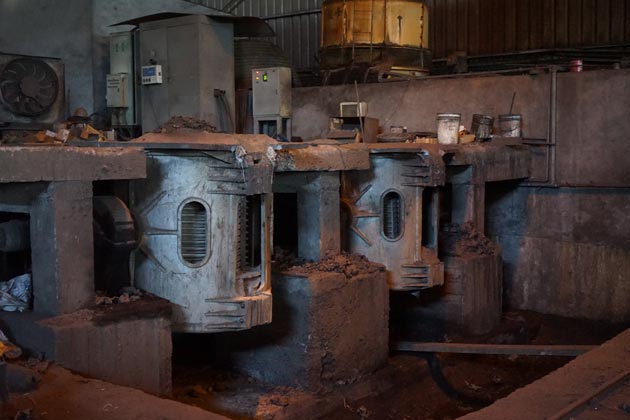Discover the Cutting-edge Techniques Made Use Of in a Metal Foundry for Superior Casting Results
In today's competitive production landscape, metal foundries are increasingly taking on ingenious techniques to improve spreading outcomes - Metal Casting. Advanced computer simulations allow for exact modeling of liquified metal actions, while 3D printing makes it possible for quick manufacturing of complicated molds. In addition, eco-friendly materials and automation simplify procedures. These developments assure significant enhancements in efficiency and high quality control. The effect of these innovations on sustainability and manufacturing methods stays to be completely checked out.
Advanced Computer Simulations in Metal Casting
Advanced computer simulations have transformed the metal casting process by enhancing accuracy and performance. These advanced tools enable designers to develop digital versions of actors elements, allowing them to analyze and predict the actions of molten metal throughout the spreading phase. By mimicing numerous criteria such as temperature, circulation price, and air conditioning prices, suppliers can recognize potential defects prior to physical manufacturing starts.
This proactive strategy reduces waste and lessens costly mistakes, eventually leading to enhanced product high quality. Additionally, simulations help with the optimization of mold styles, making sure that they meet the specific requirements of each job. The combination of computational liquid characteristics (CFD) and finite aspect analysis (FEA) more adds to the accuracy of these simulations, offering understandings that were formerly unattainable. Consequently, progressed computer system simulations have actually ended up being a vital component of contemporary metal foundries, significantly progressing the industry's capacities.
3D Printing for Molds and Patterns
3D printing has arised as a groundbreaking strategy for developing mold and mildews and patterns in the metal foundry market. This innovation allows the quick manufacturing of complicated geometries that typical production methods have a hard time to accomplish. By utilizing additive production, foundries can create elaborate designs with minimized preparations and product waste. The ability to create mold and mildews as needed enables for better versatility in layout iterations, helping with faster prototyping and alterations.
3D printing can utilize a range of products, consisting of steels and plastics, customized to certain casting demands. This flexibility boosts the precision of molds, causing superior spreading end results with improved surface finishes. Additionally, the decrease in the variety of components called for streamlines setting up procedures, even more maximizing manufacturing effectiveness. As foundries remain to adopt 3D printing, they are positioned to redefine sector requirements, paving the method for development and boosted productivity in metal spreading procedures.
Eco-Friendly Products and Processes
As the metal foundry sector deals with boosting pressure to decrease its environmental footprint, the adoption of eco-friendly products and procedures has actually ended up being important. Shops are currently exploring lasting options to standard products, such as utilizing recycled steels and bio-based binders. These products not only minimize waste however additionally reduced energy consumption during manufacturing.
Furthermore, advancements in sand casting methods have actually led to the usage of synthetic sands that are less hazardous to the atmosphere. Shops are additionally applying cutting-edge procedures like molten metal therapy that reduces emissions and boosts the top quality of cast items.
Water-based finishings have changed poisonous solvents, advertising a more secure job environment. By incorporating these environment-friendly methods, metal foundries can markedly reduce their environmental effect while keeping top quality casting results. This change not only benefits the environment however likewise straightens with the expanding customer need for lasting manufacturing options
Automation and Robotics in Foundry Workflow
While the metal foundry industry welcomes development, the assimilation of automation why not find out more and robotics is changing procedures considerably. Automated systems enhance procedures such as mold making, metal pouring, and casting finishing, considerably boosting performance. Robotics facilitate the handling of hefty materials, lowering the threat of work environment injuries and making certain safer atmospheres.

Even more, making use of automated led automobiles (AGVs) enhances material transport within centers, guaranteeing timely distribution of components to appropriate workstations. By carrying out these innovations, foundries can adjust to varying needs with higher agility, eventually leading to enhanced success and competitiveness on the market. As automation and robotics proceed to develop, they hold the prospective to redefine conventional foundry methods and drive further innovations in casting strategies.
Real-Time Tracking and Quality Assurance Techniques
The improvements in automation and robotics have paved the way for much more innovative methods to high quality guarantee in metal foundries. Real-time tracking systems make use of advanced sensing units and data analytics to track vital criteria throughout the casting process. These systems continuously analyze variables such as temperature level, stress, and material composition, allowing instant detection of variances from developed requirements.
Quality control methods now incorporate device learning formulas that analyze historical information to forecast prospective defects prior to they happen. This aggressive strategy lessens waste and improves total production efficiency. Furthermore, incorporated comments loops enable fast adjustments, making certain that each casting meets rigid top quality demands.
The implementation of digital doubles-- virtual replicas of physical properties-- has actually likewise revolutionized quality assurance, permitting designers to imitate and enhance procedures in real-time. Together, these cutting-edge strategies substantially improve the reliability and top quality of spreadings, setting brand-new sector criteria in metal foundry procedures.
Often Asked Inquiries
What Kinds of Metals Are Frequently Cast in Foundries?
Generally cast metals in foundries include light weight aluminum, bronze, iron, and brass. Each metal shows special residential or commercial properties, making them appropriate for various applications, such as automotive components, equipment, and creative Check This Out sculptures, enhancing their adaptability in manufacturing.

How much time Does the Casting Process Commonly Take?
The casting procedure usually takes numerous hours to days, depending upon elements such as the complexity of the mold and mildew, sort of metal made use of, and air conditioning demands. Each stage influences the general period significantly.
What Safety and security Measures Are in Area for Foundry Workers?

How Are Flaws in Castings Identified and Addressed?
Flaws in castings are identified through visual evaluations and non-destructive testing techniques. Once discovered, foundry employees resolve them by refining processes, readjusting product make-ups, and implementing corrective procedures to ensure top quality and compliance with criteria.
What Is the Price Range for Metal Casting Providers?
The price array for metal casting services usually varies in between $1 to $10 per extra pound, depending on factors such as product kind, complexity of the design, and production volume, affecting general pricing substantially.
In today's competitive manufacturing landscape, metal foundries are increasingly embracing cutting-edge strategies to enhance spreading outcomes. As the metal foundry sector deals with raising stress to reduce its environmental impact, the fostering of eco-friendly products and processes has actually come to be necessary. Factories are now exploring sustainable options to conventional materials, such as making use of bio-based binders and recycled steels. By integrating these green practices, metal foundries can markedly lower their ecological influence while maintaining high-grade spreading outcomes. The innovations in automation and robotics have led the means for extra advanced methods to quality assurance in metal foundries.